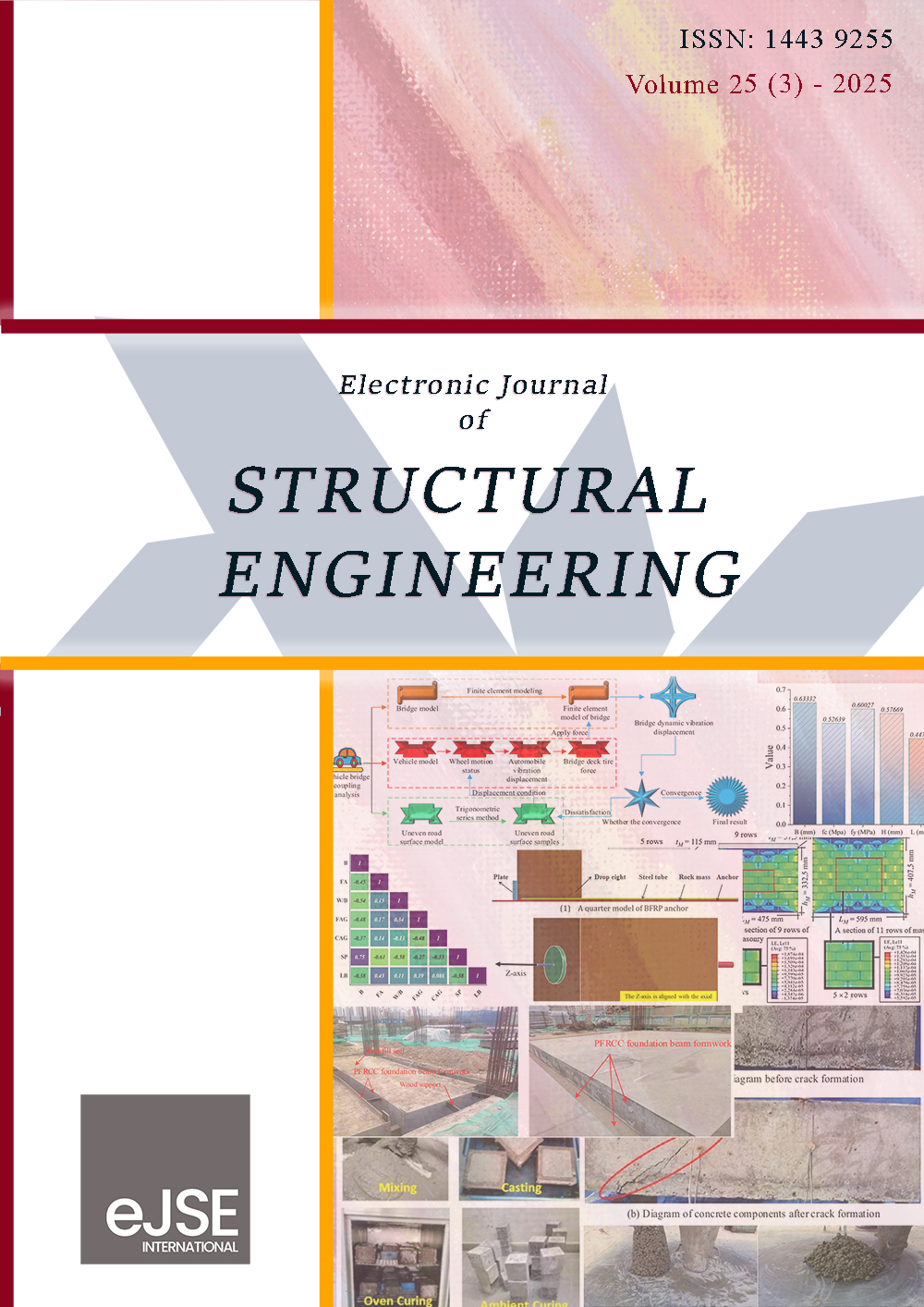Determination of Effective Stiffness Characteristics of Unreinforced Masonry Using Numerical Homogenization
DOI:
https://doi.org/10.56748/ejse.24757Keywords:
Representative volume element, Masonry, Anisotropic homogeneous body, Effective stiffness, Numerical homogenizationAbstract
The article presents a homogenization method for determining the effective properties of brickwork through numerical modeling. The selection of representative volume elements (RVEs) for characterizing masonry is justified. Numerical experiments demonstrate that reliable stress-strain data require testing a fragment of nine brick rows (four bricks wide). A nine-row stretcher-bond fragment serves as a representative component for multi-row brickwork of any configuration, enabling deformation analysis without large-scale experiments. A method is proposed to determine the stiff characteristics of unreinforced masonry as an anisotropic homogeneous body using numerical loading simulations. The stiffness coefficient matrix is derived from finite element analysis (FEA) under compressive and shear loads. Comparisons between heterogeneous and homogenized models confirm the method’s accuracy (<5% error), bridging micromechanics and structural analysis.
Downloads
References
Adishchev, V. V., & Shakarneh, O. M. D. (2023). Numerical modeling of the stress-strain state in masonry reinforced with reinforcing meshes. News of Universities. Construction, 771(3), 5–21.
Adishchev, V. V., & Shakarneh, O. M. D. (2024). Identification of effective stiffness characteristics of masonry based on a comparative analysis of the results of numerical and physical experiments. News of Universities. Construction, 788(8), 5–21. DOI: https://doi.org/10.32683/0536-1052-2023-771-3-5-21
Armbrister, O. I., Okoli, C. E. E., & Shanbhag, S. (2015). Micromechanics predictions for two-phased nanocomposites and three-phased multiscale composites: A review. Journal of Reinforced Plastics and Composites, 34(8), 605–623. DOI: https://doi.org/10.1177/0731684415574297
Bargmann, S., et al. (2018). Generation of 3D representative volume elements for heterogeneous materials: A review. Progress in Materials Science, 96, 322–384. DOI: https://doi.org/10.1016/j.pmatsci.2018.02.003
Berto, L., Saetta, A., Scotta, R., & Vitaliani, R. (2002). An orthotropic damage model for masonry structures. International Journal for Numerical Methods in Engineering, 55(2), 127–157. DOI: https://doi.org/10.1002/nme.495
Buryachenko, V. A. (2001). Multiparticle effective field and related methods in micromechanics of composite materials. Applied Mechanics Reviews, 54(1), 1–47. DOI: https://doi.org/10.1115/1.3097287
Briccoli Bati, S., Ranocchiai, G., & Rovero, L. (1999). A micromechanical model for linear homogenization of brick masonry. Materials and Structures, 32, 22–30. DOI: https://doi.org/10.1007/BF02480408
Christensen, R. M. (1990). A critical evaluation for a class of micromechanics models. Journal of the Mechanics and Physics of Solids, 38(3), 379–404. DOI: https://doi.org/10.1016/0022-5096(90)90005-O
Ghanooni-bagha, M., Tarvirdi Yaghbasti, M., & Ranjbar, M. R. (2016). Determination of Homogeneous Stiffness Matrix for Masonry Structure by means of Homogenizing Theorem. Journal of Materials and Environment al Science, 7(5), 1773–1790.
Kashevarova, G. G., & Trufanov, N. A. (2005). Numerical analysis of effective elastic properties of brickwork material. Mechanics of Composite Materials and Structures, 11(1), 49–60.
Kawa, M., Pietruszcza, S., & Shieh-Beygi, B. (2008). Limit state of brick masonry based on homogenization approach. International Journal of Solids and Structures, 45, 998–1016. DOI: https://doi.org/10.1016/j.ijsolstr.2007.09.015
Luciano, R., & Sacco, E. (1998). Variational methods for the homogenization of periodic heterogeneous media. European Journal of Mechanics - A/Solids, 17 (4), 599-617. DOI: https://doi.org/10.1016/S0997-7538(99)80024-2
Muzel, S. D., Bonhin, E. P., Guimarães, N. M., & Guidi, E. S. (2020). Application of the finite element method in the analysis of composite materials: A review. Polymers, 12(4), 818. DOI: https://doi.org/10.3390/polym12040818
Pande, G. N., Liang, J. X., & Middleton, J. (1989). Equivalent elastic moduli for brick masonry. Computers and Geotechnics, 8, 243–265. DOI: https://doi.org/10.1016/0266-352X(89)90045-1
Pietruszczak, S., & Niu, X. (1992). A mathematical description of macroscopic behavior of brick masonry. International Journal of Solids and Structures, 29, 531–546. DOI: https://doi.org/10.1016/0020-7683(92)90052-U
Pindera, M.-J., Khatam, H., Drago, A. S., & Bansal, Y. (2009). Micromechanics of spatially uniform heterogeneous media: A critical review and emerging approaches. Composites Part B, 40(5), 349–378. DOI: https://doi.org/10.1016/j.compositesb.2009.03.007
Raju, B., Hiremath, S. R., & Mahapatra, D. R. (2018). A review of micromechanics-based models for effective elastic properties of reinforced polymer matrix composites. Composite Structures, 204, 607–619. DOI: https://doi.org/10.1016/j.compstruct.2018.07.125
Sanchez-Palencia, E. (1980). Non-Homogeneous Media and Vibration Theory. Springer, Berlin.
Singh, I. V., Shedbale, A. S., & Mishra, B. K. (2016). Material property evaluation of particle reinforced composites using finite element approach. Journal of Composite Materials, 50(20), 2757–2771. DOI: https://doi.org/10.1177/0021998315612539
Uva, G., & Salerno, G. (2006). Towards a multiscale analysis of periodic masonry brickwork: A FEM algorithm with damage and friction. International Journal of Solids and Structures, 43(13), 3739-3769. DOI: https://doi.org/10.1016/j.ijsolstr.2005.10.004
Wang, G., Li, Y., Nguyen, H., & Hitlar, N. (2007). Effective elastic stiffness for periodic masonry structures via eigenstrain homogenization. Journal of Materials in Civil Engineering, 19, 269–277. DOI: https://doi.org/10.1061/(ASCE)0899-1561(2007)19:3(269)
Wang, Y., & Huang, Z. (2017). A review of analytical micromechanics models on composite elastoplastic behaviour. Procedia Engineering, 173, 1283–1290. DOI: https://doi.org/10.1016/j.proeng.2016.12.159
Yim, S. O., Lee, W. J., Cho, D. H., et al. (2015). Finite element analysis of compressive behavior of hybrid short fiber/particle/mg metal matrix composites using RVE model. Metals and Materials International, 21(2), 408–414. DOI: https://doi.org/10.1007/s12540-015-4306-0
Downloads
Published
How to Cite
Issue
Section
License
Copyright (c) 2025 Omar Shakarneh

This work is licensed under a Creative Commons Attribution 4.0 International License.







